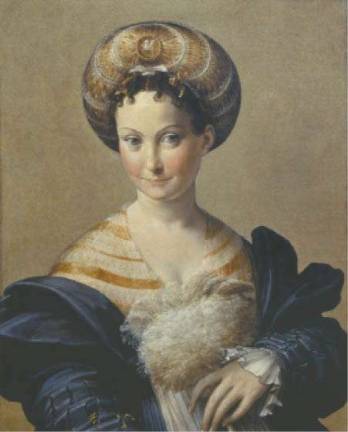More Than a Muse at The Frick

A Renaissance portrait in the U.S. for the first time
Upon seeing Parmigianino's masterpiece, Schiava Turca (Turkish Slave, c. 1531-1534), for the first time in the Oval Room of The Frick Collection, it is hard not to be struck by a sense of déjà vu. Just last fall, the room played host to another celebrated female portrait, Vermeer's Girl with a Pearl Earring (c.1665), with lines that wrapped around the block.
This time around, the crowds are thinner. The painting, and the artist, that are the focus of the current show, The Poetry of Parmigianino's Schiava Turca (through July 20, 2014), do not elicit nearly the same passion and excitement. Vermeer's Girl received star treatment, exhibited in exquisite isolation in the Oval Room.
Schiava Turca-and its creator, Francesco Mazzola (1503-1540), dubbed "Parmigianino" after his birthplace, Parma, in northern Italy-may not rise to the level of rock star and warrant the same VIP treatment. The painting is grouped with four other Renaissance portraits. But the experience of viewing and decoding Schiava Turca bears eerie similarities to parsing Vermeer's icon.
Like Girl, the work is shrouded in mystery. Its sitter is unknown and, as scholars have noted, she may be an idealization of female beauty, with no real-life reference point. But Aimee Ng, guest curator, rejects this notion and theorizes that the woman has a real identity: she's a poet. Taking it one step further, she posits that the poet is Veronica Gambara from Correggio, a city near Parma. But hard evidence is lacking to positively support the link to Gambara.
In short, the sitter is neither Turkish nor a slave. She was identified as both in 1704 by a cataloguer at the Uffizi Gallery in Florence, who misinterpreted her headgear and the chain on her sleeve as the earmarks of a Turkish slave. In fact, they were signifiers of an elite social class. The headgear-a balzo, a ball-shaped hat, not an actual turban-marked her association with the northern Italian courts.
The hat's circular shape mirrors the shape of an ivory-handled fan, a sumptuous ball of ostrich feathers that the subject holds to her breast. But its most remarkable feature is an ornament bearing the likeness of a winged horse, presumably Pegasus from Greek mythology, a symbol of poetry and creativity. Believed to be a "hat badge," such adornments were typically worn by men.
Scholars have suggested, then, that the sitter is linked to poetry-a muse for men, most likely. But the Frick's curator rejects this idea, arguing that the woman herself is a creative force. She points to the figure's forthright gaze, her "twisting," assertive pose, and the hat badge-all common features of Renaissance depictions of men, but not of women-to make the case that the sitter is a poet in her own right and not a mere source of inspiration for men.
In his lifetime, Parmigianino had a big reputation. He was regarded as a successor to Raphael (1483-1520), with biographer Giorgio Vasari recording that he was "celebrated as a Raphael reborn."
The current show marks the Frick's third collaboration with the Foundation for Italian Art & Culture to bring portraits of Renaissance women to New York. In its first collaboration in 2004, Raphael's La Fornarina (1518-1520) traveled to the museum from Rome; Parmigianino's Antea (c. 1531-34) subsequently made the journey from Naples.
As the curator explains in the catalogue, Antea bears marked similarities to Schiava Turca; the two were possibly derived from the same drawings. Both paintings depict noblewomen in elaborate "costumes"; they each wear a partlet (a garment with a plunging neckline), a silk dress that falls off the shoulder, and a white apron.
But Schiava Turca is a bust-length portrait (Antea is a three-quarter-length work) and, except for a barely visible thin, gold band on the sitter's ring finger, devoid of jewelry. But that gold band is a possible clue to the woman's identity. Though poet Veronica Gambara was a widow, the curator believes that she may have continued to wear her wedding ring, and that its faint depiction in the picture reflects her husband's absence.
Renaissance artists competed with poets to immortalize female beauty. Parmigianino was an especially ardent competitor. So while Schiava Turca's sitter was "more than a muse" and a poet herself, the artist in the end "plays an ultimate reversal," Ms. Ng writes. "In his portrait, the sitter becomes muse again, inspiring him?Parmigianino's painted poetry has the last word."
The Poetry of Parmigianino's Schiava Turca (through July 20, 2014) at The Frick Collection, 1 East 70th Street, at Fifth Avenue